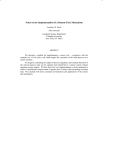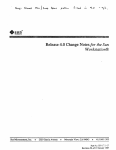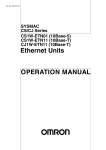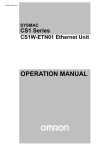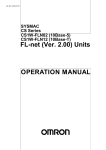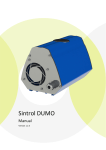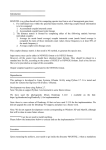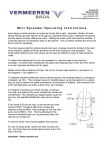Download 3-8 Creating Routing Tables
Transcript
Section Creating Routing Tables 3-8 Use the following procedure to create the I/O table. Initial screen SHIFT CH :DM 000000 I/O TBL ? CHG 000000 I/O TBL WRIT ???? WRITE Password 000000CPU BU ST? 0:CLR 1:KEEP or (Save or clear the CPU Bus Unit System Setup.) 000000 I/O TBL WRIT OK 3-8 Creating Routing Tables When the FINS communications service is used, routing tables must be created in advance. Routing tables are required in the following circumstances. • When the FINS communications service is used on an Ethernet network (including when communications are only carried out between FA networks via an Ethernet network). • When there are multiple Communications Units mounted to the PC, and socket services are requested by executing the CMND(490) instruction. If neither of these circumstances apply, then a routing table is not required. In that case, proceed to 3-9 System Setup. The routing table is required not only for nodes communicating via the FINS communications service but for all relay nodes on the network. 3-8-1 Routing Table Overview The routing tables describe the transmission path for FINS messages when the FINS communications are used. It consists of two tables: A local network table and a relay network table. 33 Section Creating Routing Tables Local Network Table 3-8 The local network table is a table describing the correspondences among unit numbers of the Communications Units and Boards mounted to each node (PC or FA Computer). Unit #04 Unit #05 Unit #06 Unit #07 Example Local Network Table Local network Unit number address 1 2 3 4 04 05 06 07 Network #1 Network #2 Network #3 Network #4 Note 1. The unit number is set (from 0 to F: 1 to 15) by the rotary switch on the front of the Ethernet Unit. 2. The network address is the number of the network (from 1 to 127) to which the Communications Unit or Board is connected. It is set when the local network table is created. Relay Network Table A relay table is a table that shows the nodes to which data should be sent first in order to send data to a network that is not connected to the local node. It shows the correspondence between the address of the final destination network, and the network address and node number of the first relay point of the path to reach there. When internetwork communications are carried out, the end network can be reached by following the relay points. The following example shows a routing table for sending data from PC #1 (the local node: network address 1, node number 1) to PC #4 (the destination node: network address 3, node number 2). Node #2 PC #3 Unit #0 (relay node) Node #1 PC #2 (relay node) Unit #1 Node #3 PC #1 (local node) Node #1 PC #4 (destination node) Node #2 Node #2 Node #1 Network #1 PC #1 relay network table Relay End network network Relay node To go to network #3, first go to node #3 at network #1. 34 Network #2 PC #2 relay network table End Relay network network Relay node To go to network #3, first go to node #2 at network #2. Network #3 End network PC #3 relay network table Local network address Unit number (To go to network #3 according to the local network table, go through the unit number of the local CPU Rack.) (The network is the same, so go to node #2 at network #3.) Section Creating Routing Tables 3-8 3-8-2 Connecting and Using a Peripheral Device for the PC Routing tables must be created by a CX-Programmer connected to the PC. (They cannot be created using a Programming Console.) For details on how to connect and use a CX-Programmer, refer to the CX-Programmer User’s Manual. Note 1. To transfer routing tables for multiple nodes to a PC in one batch, connect the CX-Programmer to a PC with only one Communications Unit mounted. Routing tables cannot be transferred to other nodes from a PC with multiple Communications Units mounted. 2. Routing tables can only be transferred as a batch to multiple nodes within the same network as the PC to which the CX-Programmer is connected. Routing Table Setting Examples Example 1: Local Network Table for a PC With Multiple Units Mounted This example shows the local network table settings for a PC to which multiple CPU Bus Units are mounted. Ethernet network Controller Link network (Network #B) (Network #A) PS: Power Supply Unit CPU: CPU Unit ETN: Ethernet Unit Unit #a Unit #b CLK: Controller Link Unit Local Network Table Local network CPU Bus Unit 35 Section Creating Routing Tables 3-8 Example 2: Three Interconnected Networks This example shows the relay network table settings for three different interconnected networks. Relay Network Table No. End network Relay network Node PC #1 Node #a Network #A PC #2 Node #b Node #c PC #3 Network #B Node #d PC #4 Node #e Node #f Network #C Node #g In the table for PC #3, for example, if network #A is taken as the end network, then network #B becomes the relay network and node #c becomes the relay node. If network #C is taken as the end network, then network #B still becomes the relay network and node #e becomes the relay node. 36 Section Creating Routing Tables 3-8 Example 3: All Nodes This example uses the following configuration to show the routing tables for all nodes. Unit #5 Node #6 Network #10 Unit #4 Node #5 Unit #7 Node #15 Network #30 Unit #3 Node #4 Unit #2 Node #3 Network #20 Unit #0 Node #1 PC #1 Routing Table (Local network table) Local network CPU Bus Unit No. PC #2 Routing Table (Local network table) Local network CPU Bus Unit No. PC #3 Routing Table (Local network table) Local network CPU Bus Unit No. PC #4 Routing Table (Local network table) Local network CPU Bus Unit No. PC #5 Routing Table (Local network table) Local network CPU Bus Unit No. PC #6 Routing Table (Local network table) Local network CPU Bus Unit No. PC #7 Routing Table (Local network table) Local network CPU Bus Unit No. Unit #1 Node #2 Unit #5 Node #5 Unit #6 Node #10 (Relay network table) End network Relay network Relay node (Relay network table) End network Relay network Relay node (Relay network table) End network Relay network Relay node (Relay network table) End network Relay network Relay node (Relay network table) End network Relay network Relay node (Relay network table) End network Relay network Relay node (Relay network table) End network Relay network Relay node 37 Section System Setup 3-9 3-9 System Setup The settings for the Ethernet Unit’s basic and special functions are made in the CPU Bus Unit System Setup. These settings, and the situations in which the settings must be made, are shown in the following table. For details on how to make the settings, refer to 4-2 CPU Bus Unit System Setup. 3-9-1 When Settings are Required Settings When settings are required Broadcast setting When Ethernet is used with UNIX 4.2BSD specifications. Address conversion method • When the FINS communications service is used on an Ethernet network. • When it is necessary to set a value outside of the range of 1 to 126 for the least significant byte of the local IP address. UDP port number for FINS When it is necessary to set a value other than the default (9600) for the FINS UDP port number. Subnet mask When it is necessary to set a subnet mask. FTP login name FTP password When setting the login name and password at the FTP server. IP address table • When the FINS communications service is used on an Ethernet network. • When it is necessary to set a value outside of the range of 1 to 126 for the least significant byte of the local IP address. IP router table • When the Ethernet network is configured with multiple segments. Mail function When the mail function is used. Refer to 4-2 CPU Bus Unit System Setup for details. 3-9-2 Using a Programming Device The settings for the CPU Bus Unit System Setup must be made by a CX-Programmer connected to the PC. The settings cannot be made using a Programming Console. For details on how to connect and use a CX-Programmer, refer to the CX-Programmer User’s Manual. 3-9-3 CPU Bus Unit System Setup Defaults The following table shows the items in the CPU Bus Unit System Setup, and their default settings. Item Default Broadcast settings All 1 (4.3BSD specifications) Address conversion method Automatic address generation UDP port number for FINS 9600 Subnet mask FTP login name 0.0.0.0 (A value corresponding to the IP address is used.) CONFIDENTIAL FTP password Not set. IP address table Not set. IP router table Not set. Mail settings None set. User-created mail data address Not set. Local mail address Not set. Destination mail address Not set. SMTP server address 0.0.0.0 (Not set.) For information on IP address table settings, refer to 3-10 Creating an IP Address Table. For information on IP router table settings, refer to 3-11 Creating an IP Router Table. For information on IP mail transmission settings, refer to Section 8 Mail. 38 Section 3-12 Checking Communications 3-10 Creating an IP Address Table An IP address table is a table of correspondences between node numbers and IP addresses, and it is used for finding IP addresses from FINS node numbers. It is necessary to register an IP address table when using the IP address table method as the method for address conversion. (For details regarding preliminary procedures, refer to 3-1 Before Operation.) An IP address table does not necessarily need to be registered in order to use the combined method for address conversion. If none is registered, however, the automatic address generation method will always be used. If the automatic address generation method is to be used exclusively, then there is no need to register an IP address table. In that case, proceed to 3-11 Creating an IP Router Table. Connecting and Using a Programming Device for the PC The IP address table must be created by a CX-Programmer connected to the PC. It cannot be created using a Programming Console. For details on how to connect and use a CX-Programmer, refer to the CX-Programmer User’s Manual. 3-11 Creating an IP Router Table An IP router table is a table of correspondences between IP router IP addresses and the network numbers of segments relayed by the IP router. If the Ethernet network is configured of multiple segments, an IP router table must be registered for communications between the segments. (For details on segments and connecting nodes, refer to 1-2-2 Node Connections.) If the Ethernet network has the minimal configuration of just one segment, there is no need to create an IP router table. In that case, proceed to 3-12 Checking Communications. Note An IP router table needs to be created only when the IP address table method or the combined method is used for address conversion. Connecting and Using a Programming Device for the PC The IP router table must be created by a CX-Programmer connected to the PC. It cannot be created using a Programming Console. For details on how to connect and use a CX-Programmer, refer to the CX-Programmer User’s Manual. 3-12 Checking Communications The Ethernet Unit supports the PING command, which is also widely supported by host computers. It also supports a function for internode testing in the FINS communications service by simply manipulating bits with a Programming Device. After the settings and connections have been completed, use either the PING command or the internode test function as required to check communications with the remote nodes. 39 Section 3-12 Checking Communications 3-12-1 PING Command and Internode Testing The following table outlines the points of difference between the PING command and internode testing. Item PING command Internode testing Main application Testing communications as an Ethernet node. Checking settings such as FINS addresses for using the FINS communications service. OMRON Units and Boards that support FINS communications service internode testing. Test objects Ethernet Units and Ethernet devices that support PING. Network classification Within Ethernet networks (including between segments). Up to three levels of Ethernet networks, and FA networks. Address system used IP addresses FINS address system (network and node numbers) Note: Requires routing tables. Transmission from Ethernet Unit PING command is issued to Ethernet Unit by CMND(490) instruction in user program. Set required parameters in DM from Programming Device, and manipulate start switch bit. Reception at Ethernet Unit When PING command is received, it is automatically returned. When internode test message is received, it is automatically returned. 3-12-2 PING Command The PING command checks communications with another node by sending an echo back request packet and receiving a response packet. Use the PING command as required to check communications. Using the PING command between nodes that support the PING command makes it possible to check whether internode communications are normal. For details on using the PING command, refer to 9-2 PING Command. 3-12-3 Internode Test The internode test is a function for checking a network by sending data to and from specified nodes and checking the responses. Use the internode test as required to check the FINS communications service settings. Using it between Communications Units and Boards that support it makes it possible to check whether the FINS communications service settings are correct. For details on using the internode test, refer to 9-3 Internode Test. Note 1. The internode test can be easily carried out by manipulating dedicated control switches for the Ethernet Unit. For details, refer to 9-3 Internode Test. 2. Internode testing of the FINS communications service can also be carried out by means of the FINS commands INTERNODE ECHO TEST and BROADCAST TEST RESULTS READ. For details, refer to 11-3-4 INTERNODE ECHO TEST and 11-3-5 BROADCAST TEST RESULTS READ. 40








